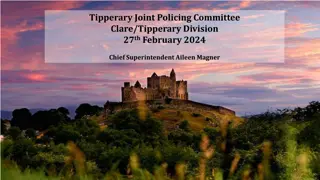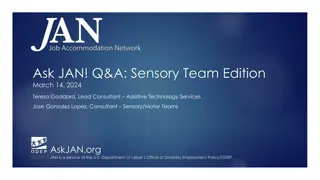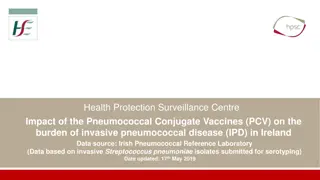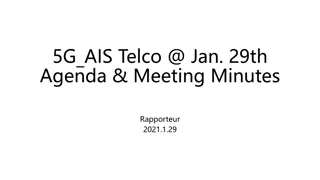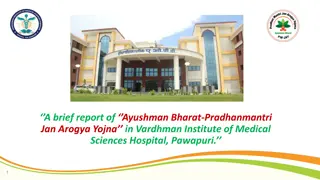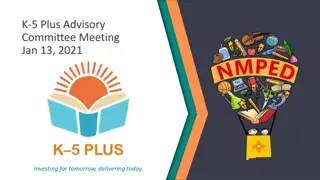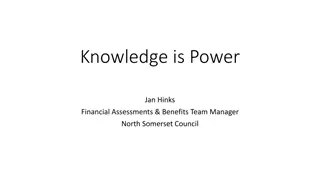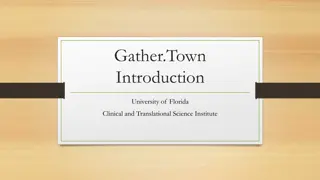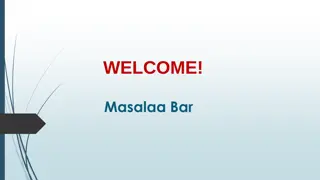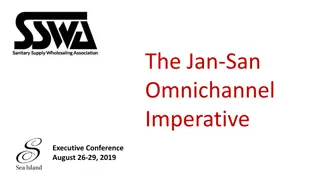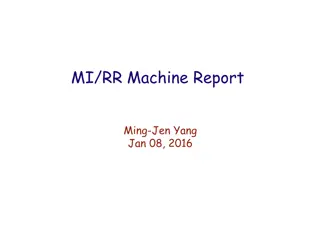
AVATAR Program Overview and Goals
Explore the AVATAR program focusing on Academic Vertical Alignment Training and Renewal, with a goal to expand career and college readiness awareness, implement regional initiatives, and close academic gaps while fostering collaboration among educational institutions.
Download Presentation

Please find below an Image/Link to download the presentation.
The content on the website is provided AS IS for your information and personal use only. It may not be sold, licensed, or shared on other websites without obtaining consent from the author. If you encounter any issues during the download, it is possible that the publisher has removed the file from their server.
You are allowed to download the files provided on this website for personal or commercial use, subject to the condition that they are used lawfully. All files are the property of their respective owners.
The content on the website is provided AS IS for your information and personal use only. It may not be sold, licensed, or shared on other websites without obtaining consent from the author.
E N D
Presentation Transcript
1 Region 5 ESC VAT Beaumont ISD Hardin-Jefferson ISD Port Arthur ISD Nederland ISD Evolution Academy Evadale ISD Lamar University Lamar State College Orange Lamar State College Port Arthur Lamar Institute of Technology http://untavatar.org
2 Overview AVATAR: Academic Vertical Alignment Training and Renewal http://untavatar.org
3 Statewide Regional Partnerships http://untavatar.org
4 Team Member Introductions Introductions: What institution/campus do you represent? What is your role with students? http://untavatar.org
5 Rationale & Purpose http://untavatar.org
6 AVATAR Goals Expand awareness of career and college readiness and vertical alignment. Create regional vertical alignment initiatives. Implement strategies to close regional academic course and expectation gaps. Identify processes to assess and celebrate regional progress. Share best practices statewide. 1. 2. 3. 4. 5. http://untavatar.org
7 AVATAR Rationale The AVATAR Process is built on Critical Conversations between secondary and postsecondary leaders and educators. The conversation is structured and facilitated in order to achieve course vertical alignment in content, cross- disciplinary, and college preparatory skills. http://untavatar.org
8 Benefits and Challenges of VAT Membership http://untavatar.org
9 AVATAR Partner & Team Benefits Team Members will Develop relationships with colleagues at other levels of education and in careers related to the discipline. Regional Partners will Collaborate across K-12 education, higher education, and with business and the community, as required by HB 5. Take ownership for college and career readiness of a common group of students. Build capacity to improve alignment of K-12 and college core curriculum. Apply principles of vertical alignment across K-12 and higher education in your discipline. Lead professional development of colleagues in the partnership. Help students make successful college and career transitions. http://untavatar.org
10 AVATAR Partner & Team Challenges Team Members must Remain active in the VAT even when it is inconvenient. Regional Partners must Maintain a vision of high standards for all students. Recruit VAT members who are change agents, and attend to their recommendations. Apply principles of vertical alignment in your own classroom first. (You will change your practice.) Model collaboration across the partnership and within your own member organization. Listen to other VAT members. Focus on students and their learning. http://untavatar.org
11 The AVATAR Process Creates and builds relationships through ongoing critical conversations Uses regional data to make alignment decisions Develops shared understanding of college and career readiness and success for students Identifies and implements intentional actions Evaluates, sustains, and shares vertical alignment work http://untavatar.org
12 Our Focus College Prep Courses (TEC Section 28.014) Partnership: Each School district shall partner with at least one institution of higher education to develop and provide courses in college preparatory Mathematics and English Language Arts. Course Design: The course mist be designed: (1) for students at the 12th grade level whose performance on: (A) an end of course assessment instrument required under section 39.023(c) does not meet college readiness standards (B) Coursework, a college entrance examination, or an assessment instrument designated under section 51.3062(c) indicates that the student is not ready to perform entry level college coursework; and (2) to prepare students for success in entry-level college courses. 28.014 (a)
13 Our Focus - Continued Method of Delivery A course developed under this section must be provided: (1) On the campus of the high school offering the course; or (2) through distance learning; or (3) as an online course provided through an institution of higher education with which the school district partners as provided by subsection (a) 28.014(b) Staff Appropriate faculty of each high school offering courses under this section and appropriate faculty of each institution of higher education with which the school district partners shall meet regularly as necessary to ensure that each course is aligned with college readiness expectations. The commissioner of education, in coordination with the commissioner of higher education, may adopt rules to administer this subsection. 28.014(c) Parent Notification Each district shall provide a notice to each district student to who subsection (a) applies and the student s parent or guardian regarding the benefits of enrolling in a course under this section.
14 Our Focus - Continued Course Credit A student who successfully completes an English Language Arts course developed under this section may use the credit earned in the course toward satisfying the advanced English Language Arts curriculum requirement for the foundation high school program under Section 28.025 (b-1) (1). A student who successfully completes a mathematics course developed under this section may use the credit earned in the course toward satisfying an advanced mathematics curriculum requirement under Section 28.025 after completion of the mathematics curriculum requirements for the foundation high school program under Section 28.025 (b-1)(2). A course provided under this section may be offered for dual credit at the discretion of the institution of higher education with which a school district partners under this section. 28.014(g)
15 Our Focus - Continued Instructional Materials Each school district , in consultation with each institution of higher education with which the district partners, shall develop or purchase instructional materials for a course developed under this section consistent with Chapter 31. The instructional materials must include technology resources that enhance the effectiveness of the course and draw on established best practices. 28.014 (g) To the extent applicable, a district shall draw from curricula and instructional materials developed under Section 28.008 in developing a course and related instructional materials under this section. A course developed under this section and the related instructional materials shall be made available to students not later than the 2014-2015 school year. 28.014(h)
16 Questions to consider Do we already have a framework for this? Are we starting from the beginning or evaluating a course currently offered? If we do have a framework: Are we offering it in any district presently? Have we evaluated the course?
17 Partners and Roles Never doubt that a small group of thoughtful, committed people can change the world. Margaret Meade
18 Scaf folding Scaf folding Student Student Success Success AVATAR is a Partnership of Regional Leaders From The Following Institutions http://untavatar.org
19 AVATAR Vertical Alignment Teams Vertical Alignment Teams (VATs): Educators and leaders representing regional ISDs, two- and four-year institutions of higher education, P-16 councils, and ESCs are committed to addressing discipline specific course and instructional alignment needs to create environments where students can make successful transitions between and among regional educational systems. http://untavatar.org
20 AVATAR Partners and Team Members Are committed to higher education access and success for all students Understand content course knowledge and skills Utilize research-based instructional strategies Demonstrate strong communication and leadership skills Are effective team players Are flexible able to deal with ambiguity http://untavatar.org
21 Partnership Benefits Build capacity to improve alignment between regional secondary and postsecondary courses and curriculum Strengthen regional secondary and postsecondary commitment to and capacity for college preparedness and success for students http://untavatar.org
22 AVATAR Partners Roles and Responsibilities Education Service Center (ESC) or Others Who Serve as Facilitators/Coordinators Convene a vertical alignment team (VAT) Expand or create a regional shared college and career readiness foundation/understanding among the partnership and team Support the P-16 council and the partnership in securing and reviewing their regional college and career readiness student data Facilitate the vertical alignment critical conversations Design and implement with the partnership their vertical alignment action plan http://untavatar.org
23 AVATAR Partners Roles and Responsibilities Independent School District (ISD) Identify campus or district leaders to participate and support vertical alignment partnership and team Identify and support discipline specific teachers and leaders to participate in the vertical alignment process Review and discuss course and instructional practices based on the VAT s work Expand and/or develop a campus or district vertical alignment plan for next academic year http://untavatar.org
24 AVATAR Partners Roles and Responsibilities Postsecondary Education: Two- and Four-Year Institutions of Higher Education General/Core Education Leaders and Faculty Identify campus, system, or district level leaders who are responsible for core or general education courses to participate in and support the vertical alignment partnership and team Identify and support discipline specific faculty and leaders to participate in the vertical alignment process Develop or review course syllabi and based on the VAT s study of vertical alignment Expand and/or develop a campus or district vertical alignment plan for the next academic year http://untavatar.org
25 AVATAR Partners Roles and Responsibilities P-16 Council Provide regional college and career readiness student data and prepare the regional data PowerPoint Serve as the recorder for the regional vertical alignment team and partnership Receive and respond to periodic reports on the progress of the partnership http://untavatar.org
26 Use of Data http://untavatar.org
27 Sources of Data Used by VATs The Texas Higher Education Coordinating Board (THECB) produces an annual profile for each public college. Data are available that show what colleges students attend by high school and how they perform as well as admission, transfer, performance, and completion data for each college. The Texas Education Agency (TEA) produces annually a Texas Academic Performance Report (TAPR) for each campus, district, and region, and for the state. These reports provide student achievement and college readiness data by gender, ethnicity, and socioeconomic status. See Handout http://untavatar.org
High School Graduates in Higher Education by the following Fall 2012-2013 Region 5 28 700 600 500 400 300 200 100 0
29 Thinking Ahead What kind of data do you need for this process? Do you have access to this data? Who can help you with this task?
30 Group Logistics http://untavatar.org
31 Meeting Logistics Meeting times Which time is best for you? AM? PM? After 4pm? Who will keep records in our meeting? Volunteer for record keeper? Communication: For direct communication with Group facilitator: Maris Peno Phone-(office) 409-951-1723; (cell) 409-658-6604 Email-mpeno@esc5.net To post Group Communication: Google Groups ELA- VATRegion5ELA@esc5.net Math- VATRegion5MATH@esc5.net http://untavatar.org
32 Group Norms http://untavatar.org
33 Norms Norms encourage behaviors that will help a group do its work and discourage behaviors that interfere with a group s effectiveness. VATs cross the cultures of K-12 and higher education, which differ in their valuing of deliberation vs. efficiency and collaboration vs. individual achievement. Norms, along with good will, can help you work across cultures. http://untavatar.org
34 Functions of Norms Standards or expectations by which individuals in a group have agreed to operate while working together Maximize team productivity and effectiveness Ensure individuals are respected Place responsibility on individuals for expected behavior to build group community http://untavatar.org
35 Some Sample Norms Begin and end the meeting on time. Notify the leader if you must be late or absent. Come prepared with assignments completed. Assure that everyone has a change to speak without being interrupted. Set time limits if this is helpful. As each meeting ends, plan for sharing with partnership leaders at your institution (Department chair, dean, provost, principal, counselor, as appropriate). http://untavatar.org
36 Individual and Group Responsibilities http://untavatar.org
37 What Is My Role as an AVATAR Partner or Team Member? What knowledge can you contribute? What skills can you bring to the group? http://untavatar.org
38 VATS draw on multiple knowledge bases. Which of these do you know well? Knowledge of content and pedagogy in your discipline Knowledge of state standards, the TEKS and/or the CCRS Pedagogical content knowledge Knowledge of state assessments, STAAR/EOC and/or the TSI Knowledge of resources and technology in your discipline Knowledge of the state curriculum Knowledge of high school learners Knowledge of college readiness Knowledge of college learners Knowledge of vertical alignment processes Knowledge of instruction http://untavatar.org
39 VATS draw on varied skills of members. Which are your strengths? Do you focus on the big picture? Facilitator Deliberator Do you see the relevance of details? Inquirer Summarizer Do you have a good imagination? Connector Are you committed to social justice? Organizer Visualizer Can you imagine a future where all students teach their educational potentials? Critic Encourager http://untavatar.org
40 Items Your Group May Want to Think About: Begin with the end in mind What do you want to achieve at each meeting? Participate actively Ask questions Share experiences and insights Make connections Help each other Tame the technology (Limit cell phone use, refrain from answering e-mails and surfing the web on laptops, iPad's, etc.) http://untavatar.org
41 Group by Subject Answer the following questions: What is your knowledge base? What are your strengths? What barriers do you anticipate in this process? How might we overcome them?
42 Next Steps Put the VAT meeting times on your calendar. Complete any assignments given. (Slide 43) Do you need any more team members to make this process more successful? Who can you recruit or appoint to be a part of this team? Do you need partners who may be part of your feeder pattern but are missing from the table? http://untavatar.org
43 Assignments Data needed to complete this process for your district or IHE Familiarize yourself and your team with the text of TEC Section 28.014 and College Readiness Standards Explore the Avatar Website www.untavatar.org Select Files College Prep Courses Gather any courses you would like to present to the group for consideration (ELA/MATH College Prep courses already developed) Complete the College Prep Course Considerations form http://www.untavatar.org
44 Steps toward AVATAR Outcomes Facilitator Meeting 1 Identify key leaders and educators who make up a regional pipeline needed for students to be college and career ready and successful Establish Understanding of the AVATAR Process Facilitator Meeting 2 Use regional data to guide decision-making Establish shared regional college and career readiness foundation and understanding of HB 5 College Prep Course Guidelines Design and implement a vertical alignment action plan which will include critical conversations around specific courses needed for students to make academic progress VAT Meetings Creating, Evaluating, Processing, Collaborating Facilitator Meeting 3 Design and implement a sustainability plan http://untavatar.org

